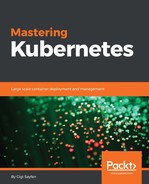- Mastering Kubernetes
- Table of Contents
- Mastering Kubernetes
- Credits
- About the Author
- About the Reviewer
- www.PacktPub.com
- Customer Feedback
- Preface
- 1. Understanding Kubernetes Architecture
- 2. Creating Kubernetes Clusters
- 3. Monitoring, Logging, and Troubleshooting
- 4. High Availability and Reliability
- High-availability concepts
- High-availability best practices
- Live cluster upgrades
- Large-cluster performance, cost, and design trade-offs
- Summary
- 5. Configuring Kubernetes Security, Limits, and Accounts
- 6. Using Critical Kubernetes Resources
- Designing the Hue platform
- Using Kubernetes to build the Hue platform
- Separating internal and external services
- Using namespace to limit access
- Launching jobs
- Kubectl get pods
- Mixing non-cluster components
- Employing init containers for orderly pod bring-up
- Evolving the Hue platform with Kubernetes
- Summary
- 7. Handling Kubernetes Storage
- Persistent volumes walkthrough
- Public storage volume types - GCE, AWS, and Azure
- GlusterFS and Ceph volumes in Kubernetes
- Flocker as a clustered container data volume manager
- Integrating enterprise storage into Kubernetes
- Summary
- 8. Running Stateful Applications with Kubernetes
- Stateful versus stateless applications in Kubernetes
- Shared environment variables versus DNS records for discovery
- Running a Cassandra cluster in Kubernetes
- Summary
- 9. Rolling Updates, Scalability, and Quotas
- Horizontal pod autoscaling
- Performing rolling updates with autoscaling
- Handling scarce resources with limits and quotas
- Choosing and managing the cluster capacity
- Pushing the envelope with Kubernetes
- Summary
- 10. Advanced Kubernetes Networking
- Understanding the Kubernetes networking model
- Kubernetes networking solutions
- Using network policies effectively
- Load balancing options
- Writing your own CNI plugin
- Summary
- 11. Running Kubernetes on Multiple Clouds and Cluster Federation
- Understanding cluster federation
- Managing a Kubernetes cluster federation
- Setting up cluster federation from the ground up
- Initial setup
- Using the official hyperkube image
- Running the federation control plane
- Registering Kubernetes clusters with federation
- Updating KubeDNS
- Shutting down the federation
- Setting up cluster federation with Kubefed
- Running federated workloads
- Summary
- 12. Customizing Kubernetes - API and Plugins
- Working with the Kubernetes API
- Extending the Kubernetes API
- Writing Kubernetes plugins
- Writing an authorization plugin
- Summary
- 13. Handling the Kubernetes Package Manager
- 14. The Future of Kubernetes
- Index
Kubernetes is a great platform for running your microservice-based applications. But, at the end of the day, it is an implementation detail. Users, and often most developers, may not be aware that the system is deployed on Kubernetes. But Kubernetes can change the game and make things that were too difficult before possible.
In this section, we'll explore the CI/CD pipeline and what Kubernetes brings to the table. At the end of this section you'll be able to design CI/CD pipelines that take advantage of Kubernetes properties such as easy-scaling and development-production parity to improve the productivity and robustness of day-to-day development and deployment.
A CI/CD pipeline is a set of steps that a set of changes by developers or operators that modify the code, data or configuration of a system, test them and deploys them to production. Some pipelines are fully automated and some are semi-automated with human checks. In large organizations, there may be test and staging environments where changes are deployed to automatically, but release to production requires manual intervention. The following diagram describes a typical pipeline.
It may be worth mentioning that developers can be completely isolated from production infrastructure. Their interface is just a Git workflow, where a good example is Deis Workflow (PaaS on Kubernetes, similar to Heroku):

When your deployment target is a Kubernetes cluster, you should rethink some traditional practices. For starters, packaging is different. You need to bake images for your containers. Reverting code changes is super easy and instantaneous by using smart labeling. It gives you a lot of confidence that, if a bad change slips through the testing net, somehow you'll be able to revert to the previous version immediately. But you want to be careful there. Schema changes and data migrations can't be automatically rolled back. Another unique capability of Kubernetes is that developers can run a whole cluster locally. That takes some work when you design your cluster, but since the microservices that comprise your system run in containers, and those containers interact via APIs, it is possible and practical to do. As always, if your system is very data-driven, you will need to accommodate for that and provide data snapshots and synthetic data that your developers can use.
-
No Comment
